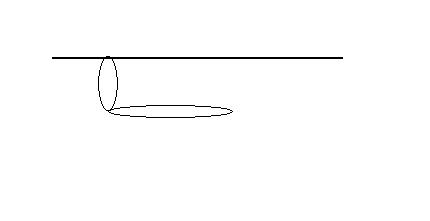Any one? Is it too tough to be answered?
Two rings of masses 'm' (smaller one) and '4m' (bigger one) are placed in the set up as shown in the diagram. The smaller ring is hung through a horizontal frictionless thread. The bigger ring is joined to the smaller ring in such a way that it can rotate freely about the point of suspension. The planes of both the rings are perpendicular to the plane of the paper. The bigger ring has a radius 'R'. After the bigger ring is released from the initial position as shown in the figure, find the angular velocity of the bigger ring when its plane becomes vertical i.e the planes of both the rings become vertical.

I used the following principles :
Let v1 be the velocity of COM of smaller ring and v2 be the velocity of the COM of bigger ring w.r.t ground frame.
1) Conservation of momentum of the system of 2 rings
0 = mv1 + 4mV2
2) Conservation of energy
4mgR = 0.5mv12 + 0.5*4m*v22 + 0.5Iω2
3) Conservation of angular momentum
Is it conserved about the point of rotation of the bigger ring if we consider the bigger ring and earth as our system of particles?
Please help me understand the concept. Correct any mistakes in the above equations if there.
-
UP 0 DOWN 0 1 8

8 Answers
(not sure )
let the upper ring be denoted by 1 and lower by 2
we have :
m1v1 = m2v2...............(1)
( v1 & v2 are vel of respective com )
by energy conservation ,
m2gr2= KE due to pure translation of com of the rings + KE due to pure rotation of rings abt their com
= 12m1v12 + 12m2v22 + 12I1ω12 + 12I2ω22 .............(2)
now for the topmost pt of the upper ring ,
v = 0 = r1ω1 - v1
so v1 = r1w1....................(3)
consider the pt common to both rings
v = v1 + r1ω1 = 2v1 = r2ω2 - v2 ......(4)
4 eqns , and v1,v2, ω1,ω2 are the 4 unknowns , it shud get solved ...
Thanks for reply qwerty. I solved the question anyways.
You made it too complex :p.....there is no need to consider the rotation of the smaller ring as it does not rotate until the bigger ring passes the vertical position... and we are required to find angular velocity of the bigger ring just at the vertical position....so no rotation of the smaller ring [1]
"as it does not rotate until the bigger ring passes the vertical position"\
are you sure ?
v = 0 = r1ω1 - v1
so v1 = r1w1....................(3)
consider the pt common to both rings
v = v1 + r1ω1 = 2v1 = r2ω2 - v2 ......(4)
I can't get this!
@qwerty:
No I don't have any theoretical explanation for that........I performed it by taking two such rings ( I have one such setup at home [3] ). I found that the upper ring does not rotate (only translates) till the bigger ring reaches the vertical position. After that, it rotates (though by only a very small angular velocity)
@swordfish
buddy tell me one thing don't u think we will need the radius of small ring??...else there will be three equations in four unknowns[after all r=radius of small ring is also an unknown] as i am getting right now.....something is missing out here in the problem[12]
oh!!!!!!! i made an error there , i though that upper ring's upper end is fixed ..... ok ok , then we wont have ω1
so we will have
m1v1 = m2v2
m2gr2 = 12m1v12 + 12m1v12 +12I2ω22
v1 = r2ω2 - v2
& assuming the rings to be uniform and of equal density , r1/r2=m1/m2